Overview
The Asana connector for Bizagi is available for download at Bizagi Connectors Xchange.
Through this connector, you will be able to connect your Bizagi processes to your Asana account and services.
For more information about this connector's capabilities, visit Bizagi Connectors Xchange.
Before you start
In order to test and use this connector, you will need:
1.Bizagi Studio previously installed.
2.This connector previously installed, via the Connectors Xchange as described at https://help.bizagi.com/platform/en/index.html?Connectors_Xchange.htm, or through a manual installation as described at https://help.bizagi.com/platform/en/index.html?connectors_setup.htm
3.An account at www.asana.com and a valid personal access token.
How to get Asana personal access token
Once you have a registered account in Asana follow this steps to get your personal access token:
1.On your app home screen click the icon with your picture and on the dropdown list that appears click My Profile Setting.

2.On the new window that appears click the Apps tab and then click Manage Developer Apps.

3.Click +Create New Personal Access Token.
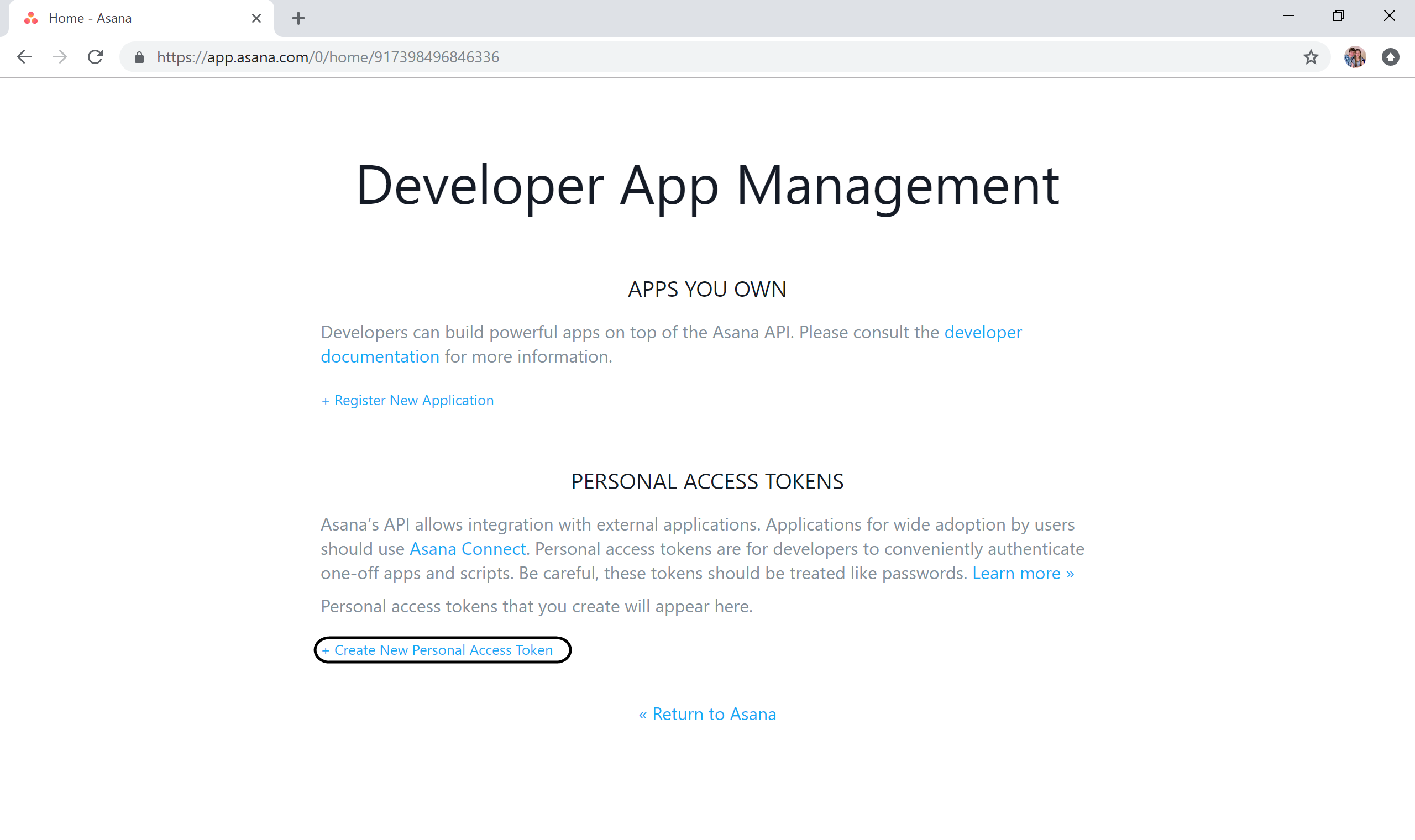
4.Add a short descriptions and click Create.

5.Copy the access token. Be careful during this operation and save your token safely, since you will not be able to see this token again.

Configuring the connector
To configure the connector (i.e its authentication parameters), follow the steps presented at the Configuration chapter in https://help.bizagi.com/platform/en/index.html?connectors_setup.htm
For this configuration, consider the following authentication parameters:
•Authentication method: Custom.
•PERSONAL_TOKEN: The generated personal access token of your Asana account (as discussed in the previous section).

Using the connector
This connector features several available methods of Asana services, which lets you to directly manage your Asana workspace directly from Bizagi.
To learn overall how/where to configure the use of a connector, refer to https://help.bizagi.com/platform/en/index.html?Connectors_Studio.htm.
When using the connector, make sure you consider the following details for the available methods.
Get available workspaces
This action gets all the workspaces the user can access.

This method does not require any input.
To configure its outputs, you can map the output collection to your workspace collection in Bizagi and make sure you map the attributes of the workspaces appropriately:

For more information about this method's use, refer to Asana's official documentation at https://asana.com/developers/api-reference/workspaces?missingtranslation=es#get.
Update Workspace
This action lets you upgrade a specific workspace.

Configure its inputs as follow:
•workspace_id: The id of the workspace (required). This parameter should be an integer in your Bizagi model.
•name: Name of the workspace (required). This parameter should be a string in your Bizagi model.

To configure its outputs, you can map the response output to your workspace entity in Bizagi and make sure you map the attributes of the workspace appropriately:

For more information about this method's use, refer to Asana's official documentation at https://asana.com/developers/api-reference/workspaces?missingtranslation=es#update.
Add User To Workspace
This action lets you add a user to a specific workspace.

Configure its inputs as follow:
•workspace_id: The id of the workspace (required). This parameter should be an integer in your Bizagi model.
•user: The user that will be added to the workspace (required). It can be the id of the user, the email or the string 'me' to add yourself. This parameter should be a string in your Bizagi model.

To configure its outputs, you can map the response output to your workspace entity in Bizagi and make sure you map the attributes of the workspace appropriately:

For more information about this method's use, refer to Asana's official documentation at https://asana.com/developers/api-reference/workspaces?missingtranslation=es#user-mgmt.
Remove User Of Workspace
This action lets you remove a user from a specific workspace.

Configure its inputs as follow:
•workspace_id: The id of the workspace (required). This parameter should be an integer in your Bizagi model.
•user: The user that will be removed from the workspace (required). It can be the id of the user, the email or the string 'me' to remove yourself. This parameter should be a string in your Bizagi model.

To configure its outputs, you can map the response output to your workspace entity in Bizagi and make sure you map the attributes of the workspace appropriately:

For more information about this method's use, refer to Asana's official documentation at https://asana.com/developers/api-reference/workspaces?missingtranslation=es#user-mgmt.
Get Workspace User
This action gets all of the users working on a specific workspace.

Configure its inputs as follow:
•workspace_id: The id of the workspace (required). This parameter should be an integer in your Bizagi model.

To configure its outputs, you can map the collection output to your users collection in Bizagi and make sure you map the attributes of the users appropriately:

For more information about this method's use, refer to Asana's official documentation at https://asana.com/developers/api-reference/workspaces?missingtranslation=es#user-mgmt
Get All Users
This action gets all the users you can access.
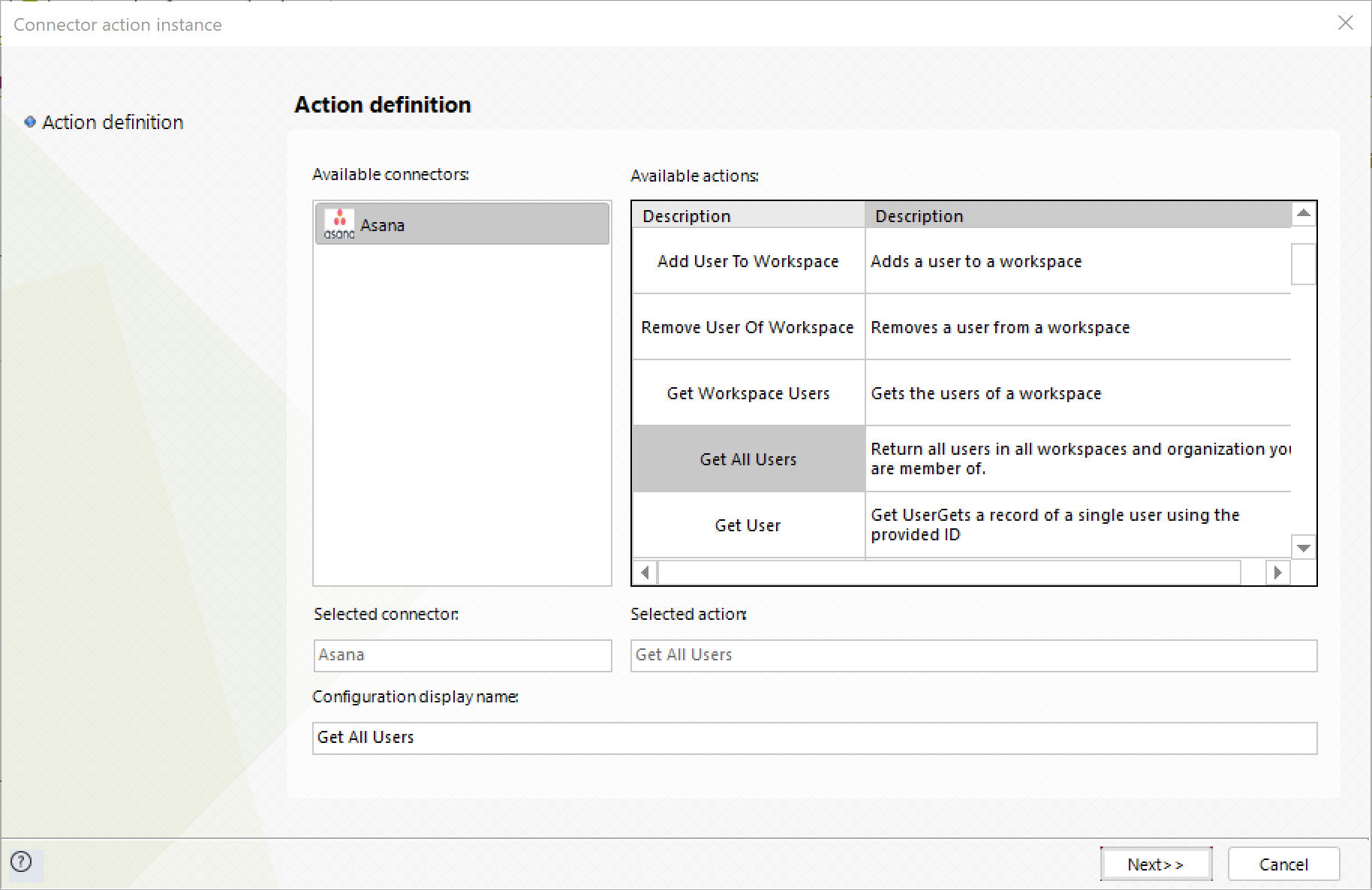
This method does not require any input.
To configure its outputs, you can map the output collection to your user collection in Bizagi and make sure you map the attributes of the users appropriately:

For more information about this method's use, refer to Asana's official documentation at https://asana.com/developers/api-reference/users?missingtranslation=es#get-all
Get User
This action gets a specific user.

Configure its inputs as follow:
•user: The user you want to get (required). It can be the id of the user, the email or the string 'me' to remove yourself. This parameter should be a string in your Bizagi model.

To configure its outputs, you can map the response output to your user entity in Bizagi and make sure you map the attributes of the user appropriately:

For more information about this method's use, refer to Asana's official documentation at https://asana.com/developers/api-reference/users?missingtranslation=es#get-single
Get All Projects
This action gets all the projects you can access.

This method does not require any input.
To configure its outputs, you can map the output collection to your project collection in Bizagi and make sure you map the attributes of the projects appropriately:

For more information about this method's use, refer to Asana's official documentation at https://asana.com/developers/api-reference/projects?missingtranslation=es#query.
Get Project
This action gets a specific project.
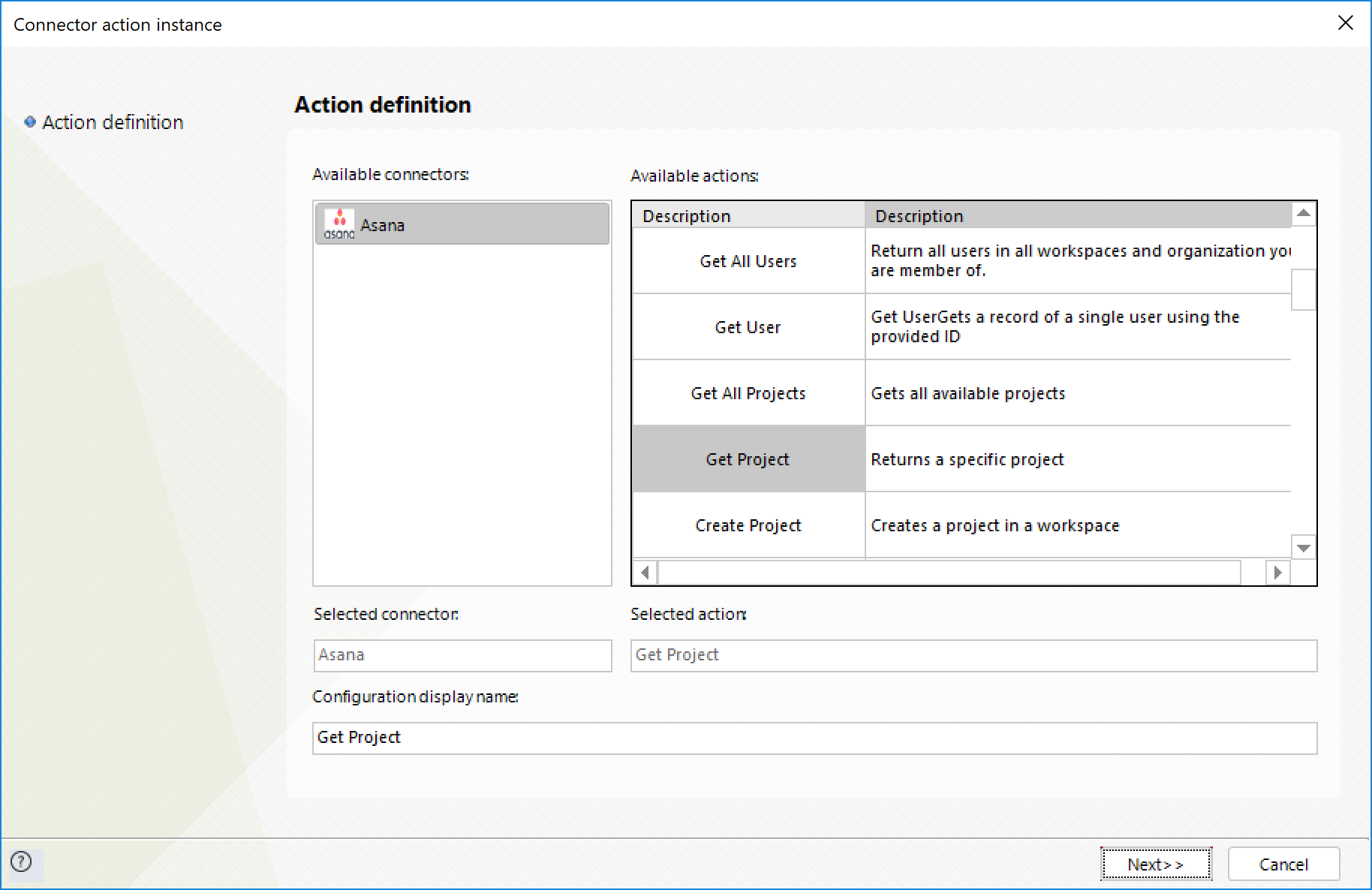
Configure its inputs as follow:
•project_id: The id of the project you want to get (required). This parameter should be an integer in your Bizagi model.

To configure its outputs, you can map the response output to your project entity in Bizagi and make sure you map the attributes of the project appropriately:

For more information about this method's use, refer to Asana's official documentation at https://asana.com/developers/api-reference/projects?missingtranslation=es#get-single.
Create Project
This action lets you create a new project in a specific workspace.

Configure its inputs as follow:
•workspace_id: The id of the workspace (required). This parameter should be an integer in your Bizagi model.
•name: The name of the project (required). This parameter should be a string in your Bizagi model.
•notes: The notes you want to add to the project. This parameter should be a string in your Bizagi model.
•due_date: The date when the project should be finished. In format YYYY-MM-DD. Ex. 2018-12-15. This parameter should be a string in your Bizagi model.

To configure its outputs, you can map the response output to your project entity in Bizagi and make sure you map the attributes of the project appropriately:

For more information about this method's use, refer to Asana's official documentation at https://asana.com/developers/api-reference/projects?missingtranslation=es#create.
Update Project
This action lets you update a specific project.

Configure its inputs as follow:
•project_id: The id of the project (required). This parameter should be an integer in your Bizagi model.
•name: The name of the project (required). This parameter should be a string in your Bizagi model.
•notes: The notes you want to add to the project. This parameter should be a string in your Bizagi model.
•due_date: The date when the project should be finished. In format YYYY-MM-DD. Ex. 2018-12-15. This parameter should be a string in your Bizagi model.
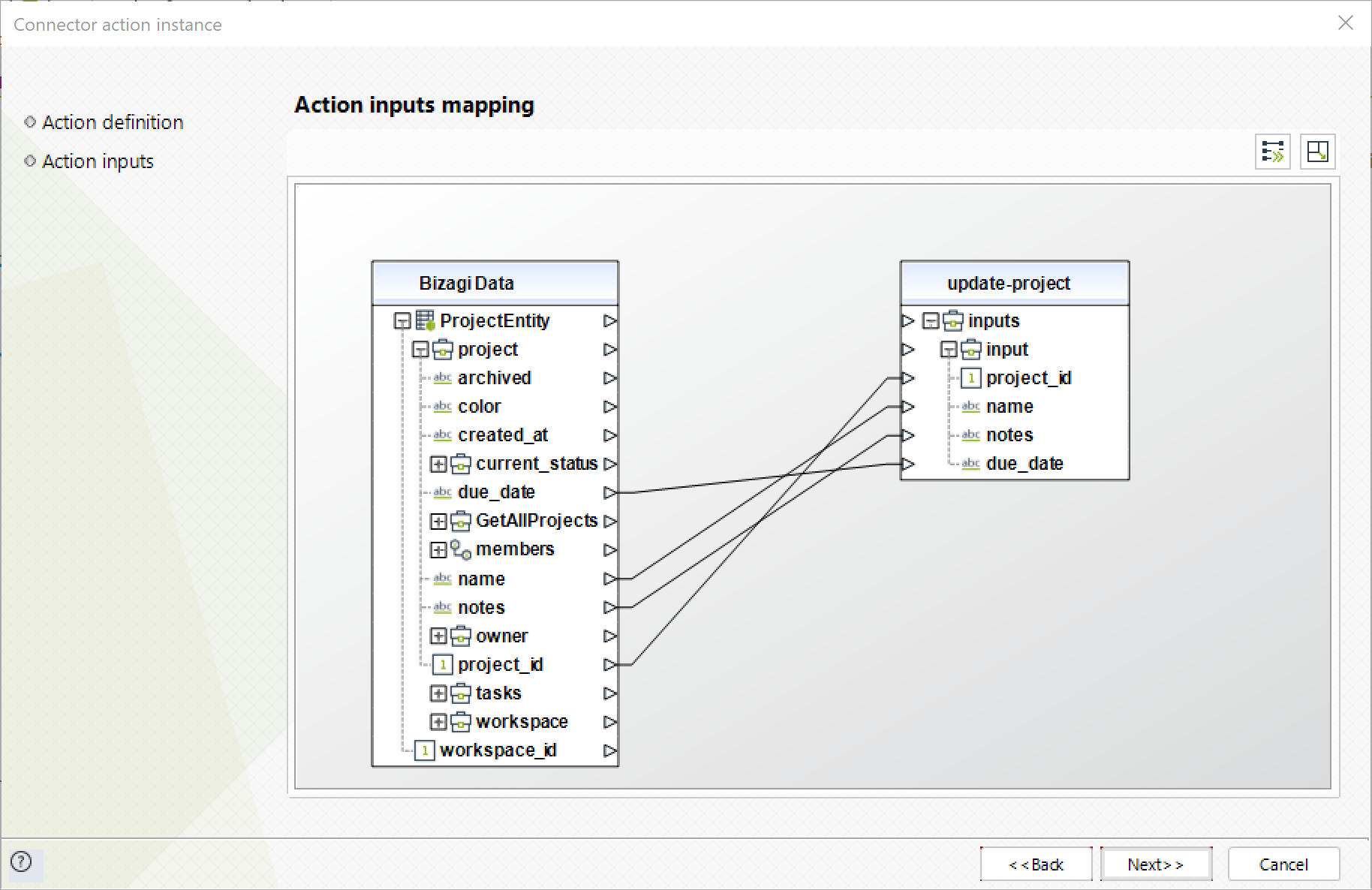
To configure its outputs, you can map the response output to your project entity in Bizagi and make sure you map the attributes of the project appropriately:

For more information about this method's use, refer to Asana's official documentation at https://asana.com/developers/api-reference/projects?missingtranslation=es#update.
Delete Project
This action lets you delete a specific project.

Configure its inputs as follow:
•project_id: The id of the project (required). This parameter should be an integer in your Bizagi model.

To configure its outputs, you can map the success output to your success attribute.

For more information about this method's use, refer to Asana's official documentation at https://asana.com/developers/api-reference/projects?missingtranslation=es#delete.
Get Project Statuses
This action gets all the status updates of a specific project.

Configure its inputs as follow:
•project_id: The id of the project (required). This parameter should be an integer in your Bizagi model.

To configure its outputs, you can map the output collection to your project status entity in Bizagi and make sure you map the attributes of the project status appropriately:

For more information about this method's use, refer to Asana's official documentation at https://asana.com/developers/api-reference/project_statuses?missingtranslation=es#query
Get A Project Status
This action gets the status updates of a specific project.

Configure its inputs as follow:
•project_status_id: The id of the project status (required). This parameter should be an integer in your Bizagi model.

To configure its outputs, you can map the response output to your project status entity in Bizagi and make sure you map the attributes of the project status appropriately:

For more information about this method's use, refer to Asana's official documentation at https://asana.com/developers/api-reference/project_statuses?missingtranslation=es#get-single.
Create Project Status
This action lets you create a status update on a specific project.

Configure its inputs as follow:
•project_id: The id of the project (required). This parameter should be an integer in your Bizagi model.
•text: Text of the status update (required). This parameter should be a string in your Bizagi model.
•color: Color of the status update (required). It can only be red, green or yellow. This parameter should be a string in your Bizagi model.

To configure its outputs, you can map the response output to your project status entity in Bizagi and make sure you map the attributes of the project status appropriately:

For more information about this method's use, refer to Asana's official documentation at https://asana.com/developers/api-reference/project_statuses?missingtranslation=es#create.
Delete Project Status
This action lets you delete a specific status update.

Configure its inputs as follow:
•project_status_id: The id of the project status (required). This parameter should be an integer in your Bizagi model.

To configure its outputs, you can map the success output to your success attribute:

For more information about this method's use, refer to Asana's official documentation at https://asana.com/developers/api-reference/project_statuses?missingtranslation=es#delete,
Get Project Sections
This action gets all the project sections of a specific project.

Configure its inputs as follow:
•project_id: The id of the project (required). This parameter should be an integer in your Bizagi model.
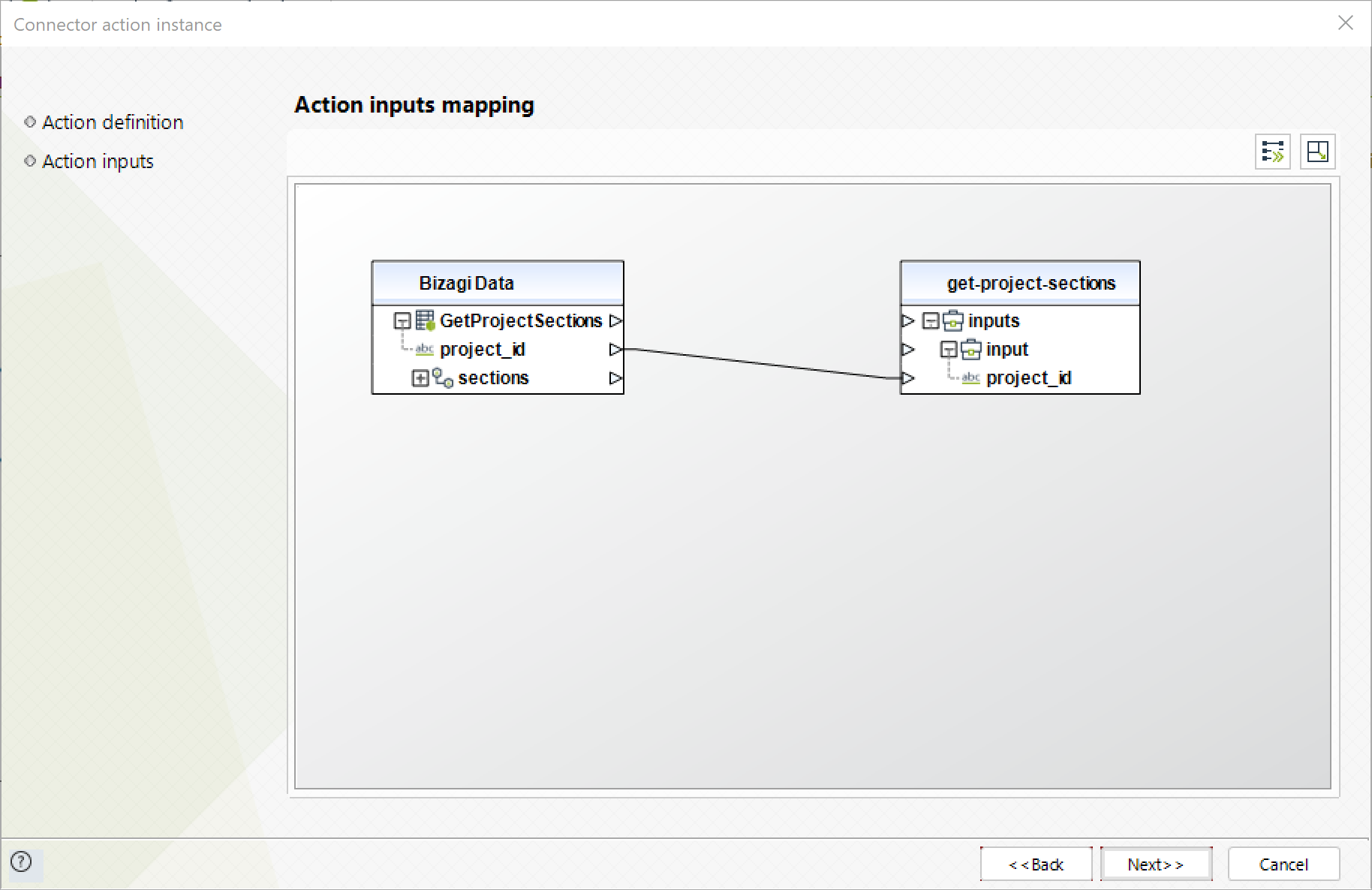
To configure its outputs, you can map the output collection to your project section collection in Bizagi and make sure you map the attributes of the project section appropriately:

For more information about this method's use, refer to Asana's official documentation at https://asana.com/developers/api-reference/sections?missingtranslation=es#find-project
Get A Project Section
This action gets a specific project section.
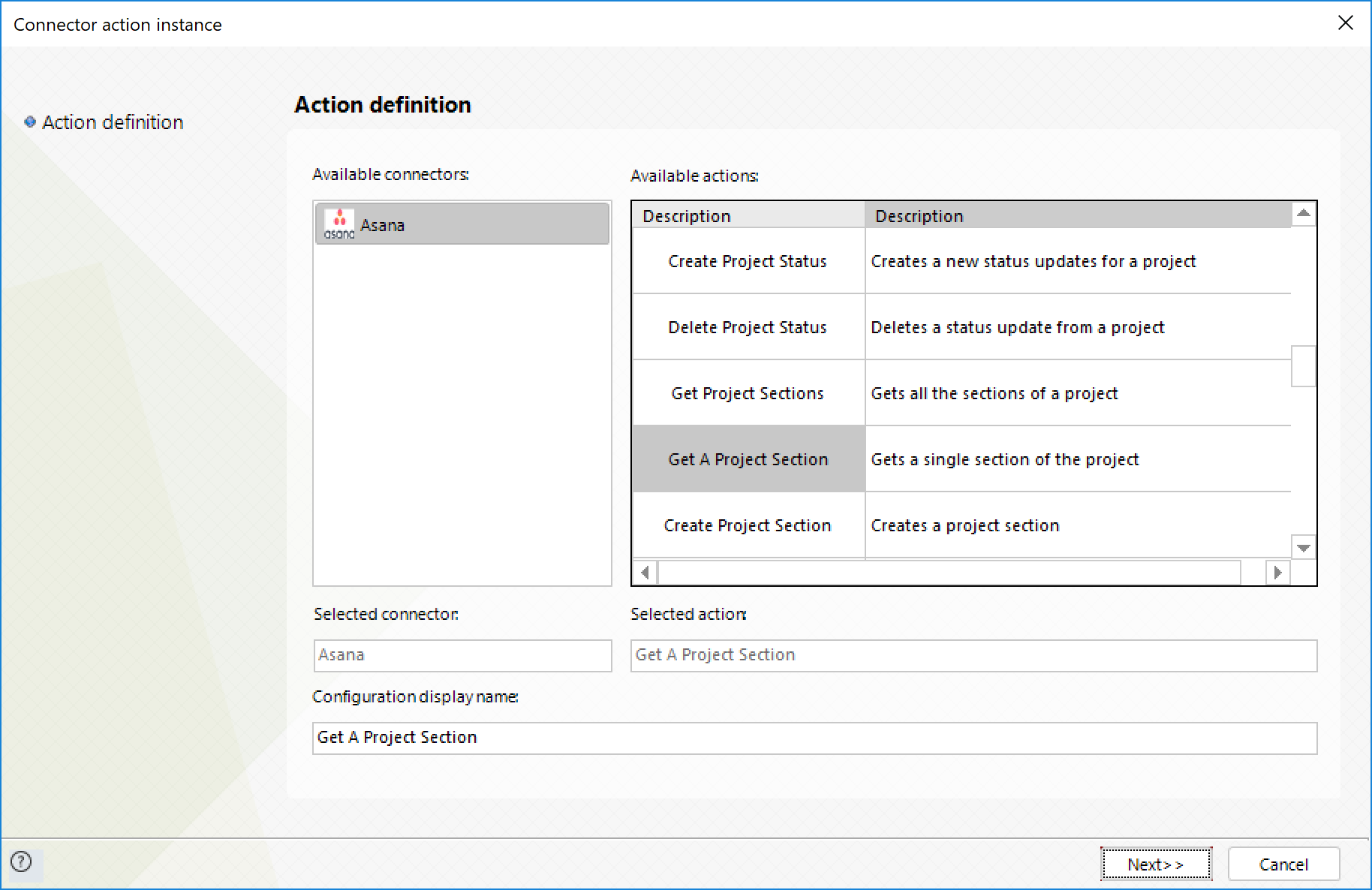
Configure its inputs as follow:
•section_id: The id of the project section (required). This parameter should be an integer in your Bizagi model.

To configure its outputs, you can map the response output to your project section entity in Bizagi and make sure you map the attributes of the project section appropriately:

For more information about this method's use, refer to Asana's official documentation at https://asana.com/developers/api-reference/sections?missingtranslation=es#get-single,
Create Project Section
This action creates a new project section in a specific project.

Configure its inputs as follow:
•project_id: The id of the project (required). This parameter should be an integer in your Bizagi model.
•name: The name of the section (required). This parameter should be a string in your Bizagi model.

To configure its outputs, you can map the response output to your project section entity in Bizagi and make sure you map the attributes of the project section appropriately:
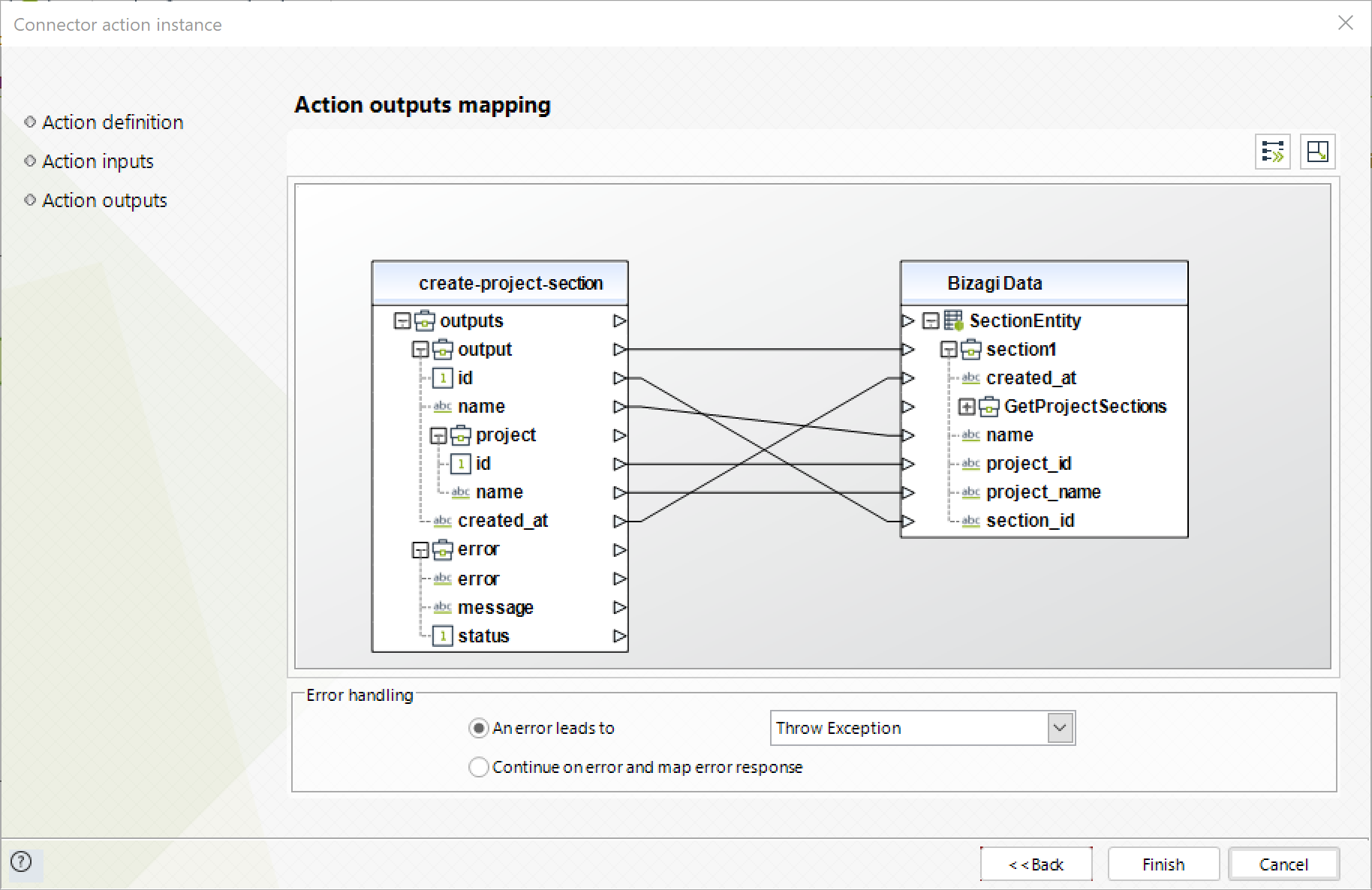
For more information about this method's use, refer to Asana's official documentation at https://asana.com/developers/api-reference/sections?missingtranslation=es#create,
Update Project Section
This action lets you update a specific project section.
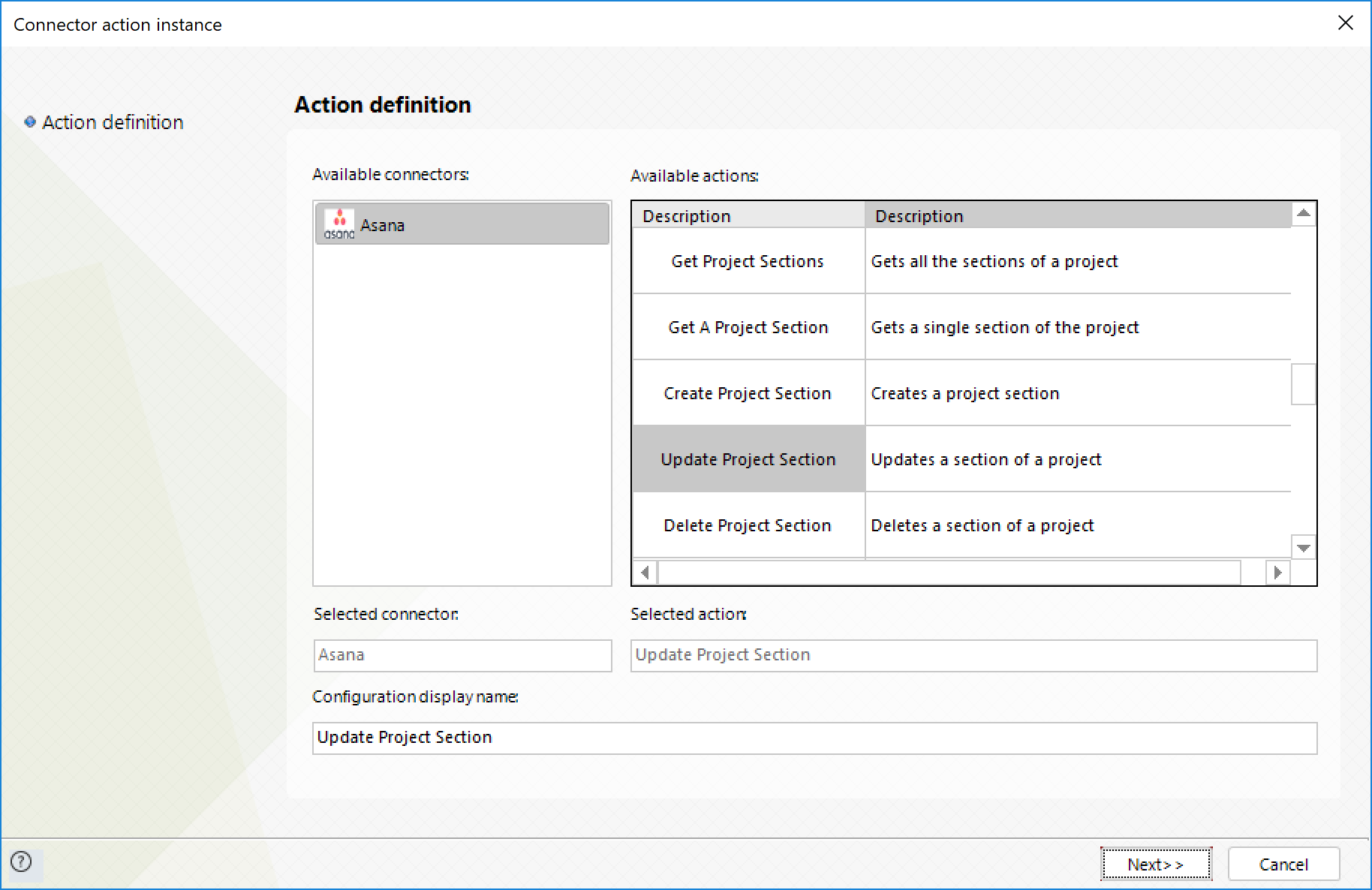
Configure its inputs as follow:
•section_id: The id of the project section (required). This parameter should be an integer in your Bizagi model.
•name: The name of the section (required). This parameter should be a string in your Bizagi model.

To configure its outputs, you can map the response output to your project section entity in Bizagi and make sure you map the attributes of the project section appropriately:
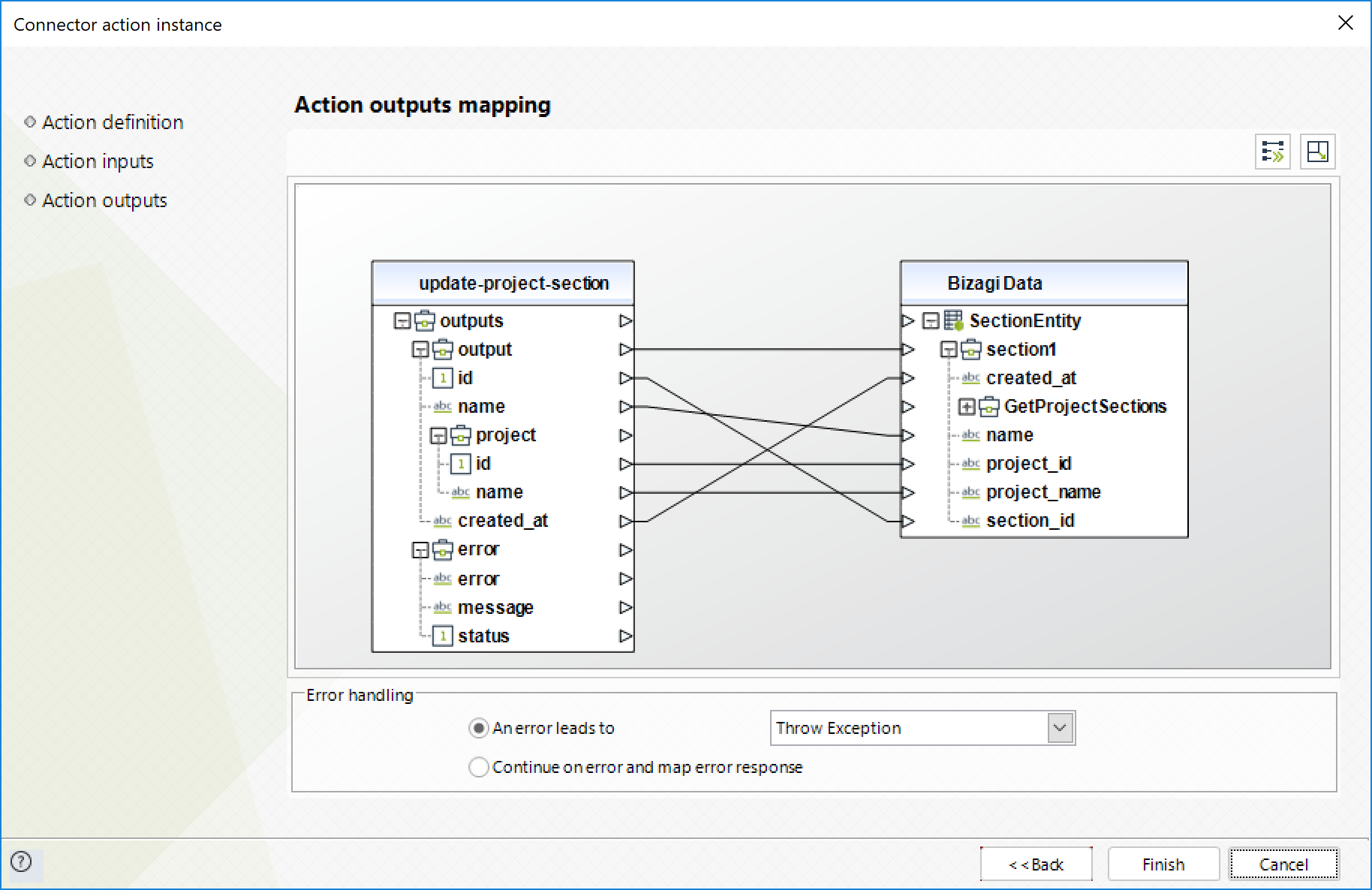
For more information about this method's use, refer to Asana's official documentation at https://asana.com/developers/api-reference/sections?missingtranslation=es#update,
Delete Project Section
This action lets you update a specific project.

Configure its inputs as follow:
•section_id: The id of the project section (required). This parameter should be an integer in your Bizagi model.

To configure its outputs, you can map the success output to your success attribute:

For more information about this method's use, refer to Asana's official documentation at https://asana.com/developers/api-reference/sections?missingtranslation=es#delete,
Get Project Tasks
This action gets all the tasks of a project.

Configure its inputs as follow:
•project_id: The id of the project (required). This parameter should be an integer in your Bizagi model.

To configure its outputs, you can map the output collection to your task collection in Bizagi and make sure you map the attributes of the tasks appropriately:
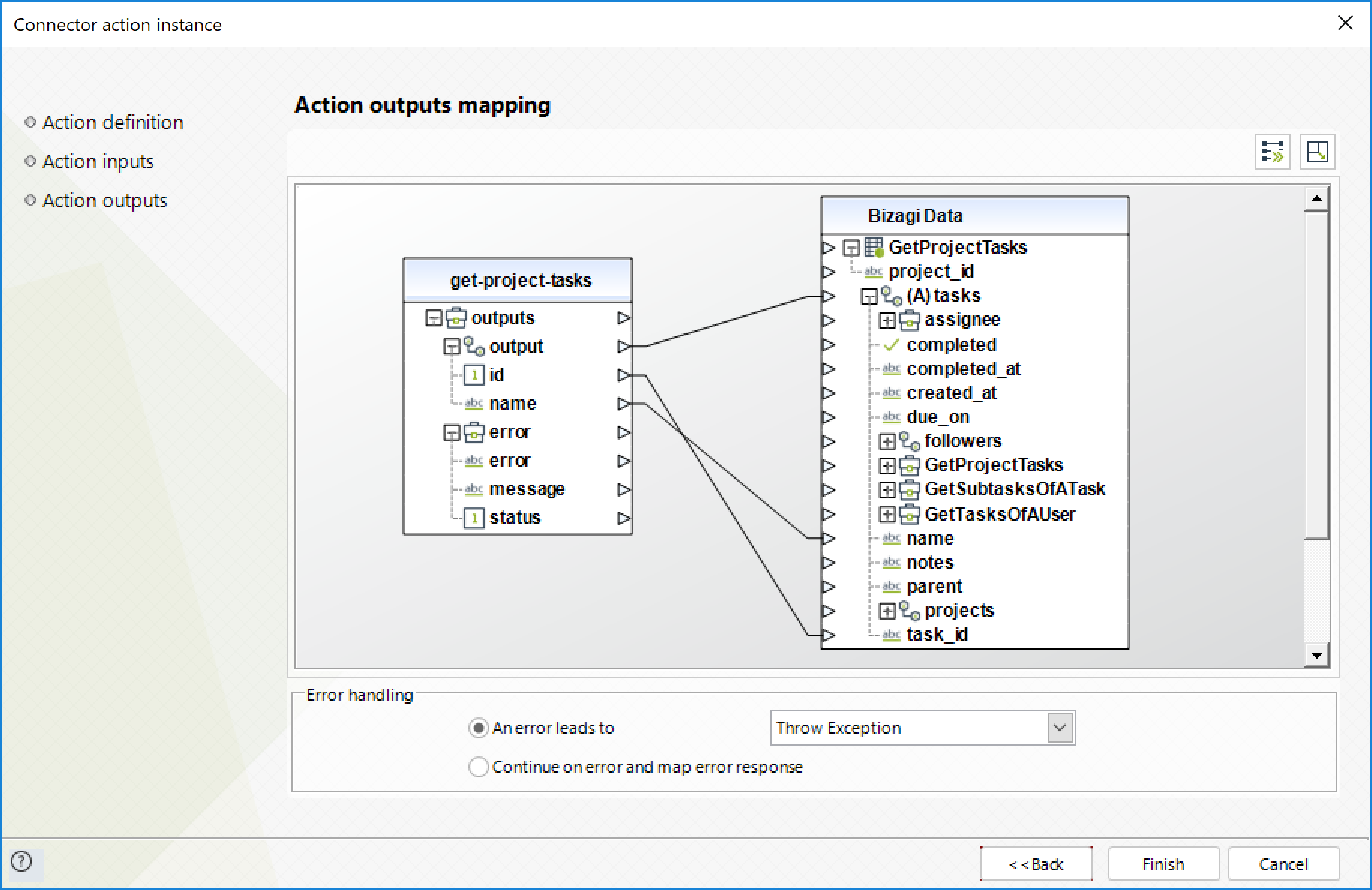
For more information about this method's use, refer to Asana's official documentation at https://asana.com/developers/api-reference/projects?missingtranslation=es#get-tasks.
Get A Task
This action gets a specific task.

Configure its inputs as follow:
•task_id: The id of the task (required). This parameter should be an integer in your Bizagi model.

To configure its outputs, you can map the response output to your task entity in Bizagi and make sure you map the attributes of the task appropriately:

For more information about this method's use, refer to Asana's official documentation at https://asana.com/developers/api-reference/tasks?missingtranslation=es#get.
Create Task
This action lets you create a new task, assign it to an user and add it to one or more projects.
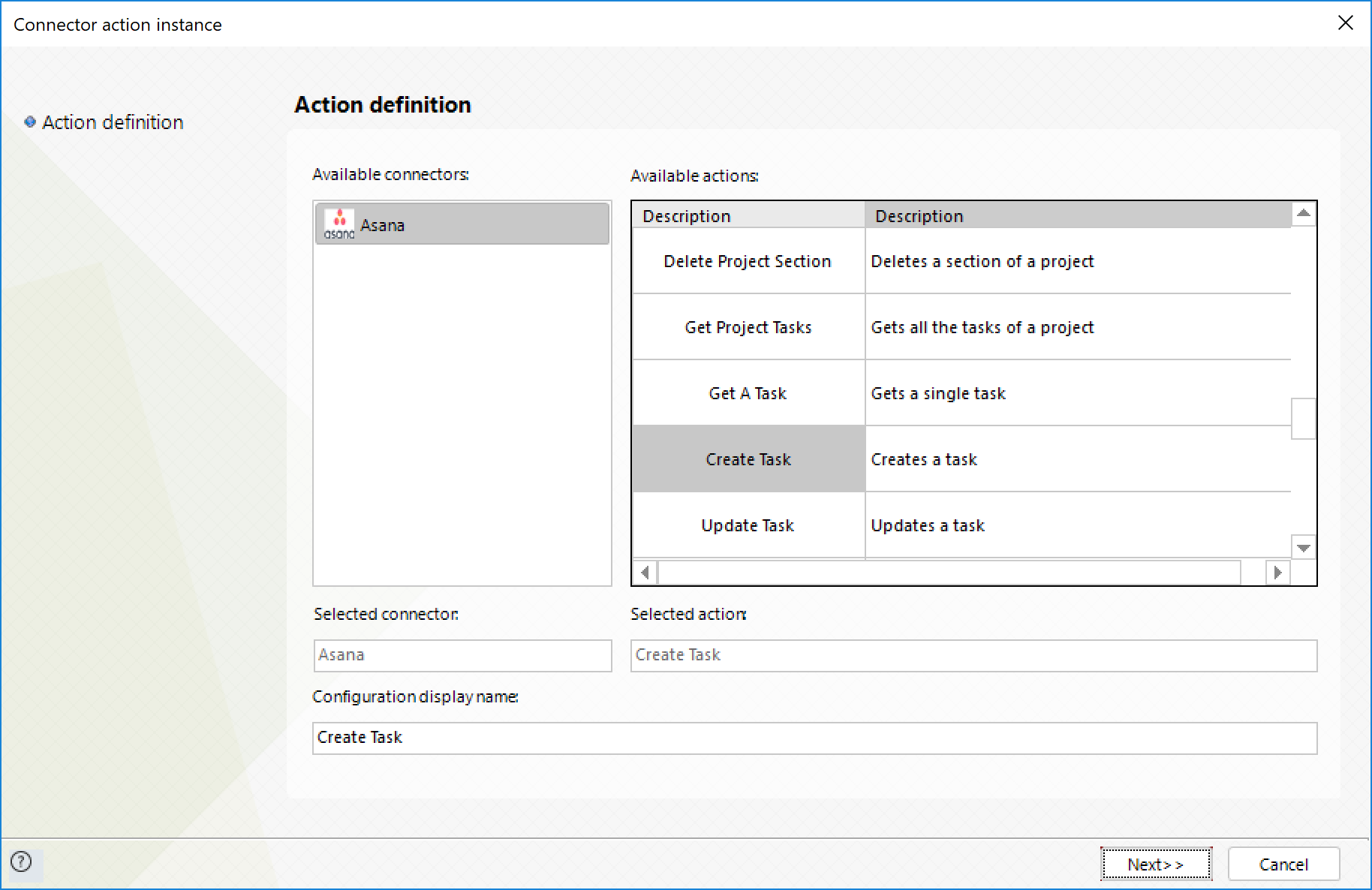
Configure its inputs as follow:
•projects: The ids of the projects separated by comma (required). This parameter should be a string in your Bizagi model.
•name: the name of the task (required). This parameter should be a string in your Bizagi model.
•notes: The notes of the task. This parameter should be a string in your Bizagi model.
•due_on: The date when the task should be finished. It should be in format YYYY-MM-DD. Ex 2018-12-15. This parameter should be a string in your Bizagi model.
•assignee: The user that will be assigned to the task. It can be the id of the user, the email or the string 'me' to assign yourself. This parameter should be a string in your Bizagi model.

To configure its outputs, you can map the response output to your task entity in Bizagi and make sure you map the attributes of the task appropriately:

For more information about this method's use, refer to Asana's official documentation at https://asana.com/developers/api-reference/tasks?missingtranslation=es#create.
Update Task
This action lets you update a task.

Configure its inputs as follow:
•task_id: The id of the task (required). This parameter should be an integer in your Bizagi model.
•name: the name of the task (required). This parameter should be a string in your Bizagi model.
•notes: The notes of the task. This parameter should be a string in your Bizagi model.
•assignee: The user that will be assigned to the task. It can be the id of the user, the email or the string 'me' to assign yourself. This parameter should be a string in your Bizagi model.

To configure its outputs, you can map the response output to your task in Bizagi and make sure you map the attributes of the task appropriately:

For more information about this method's use, refer to Asana's official documentation at https://asana.com/developers/api-reference/tasks?missingtranslation=es#update.
Delete Task
This action lets you delete a task.

Configure its inputs as follow:
•task_id: The id of the task (required). This parameter should be an integer in your Bizagi model.
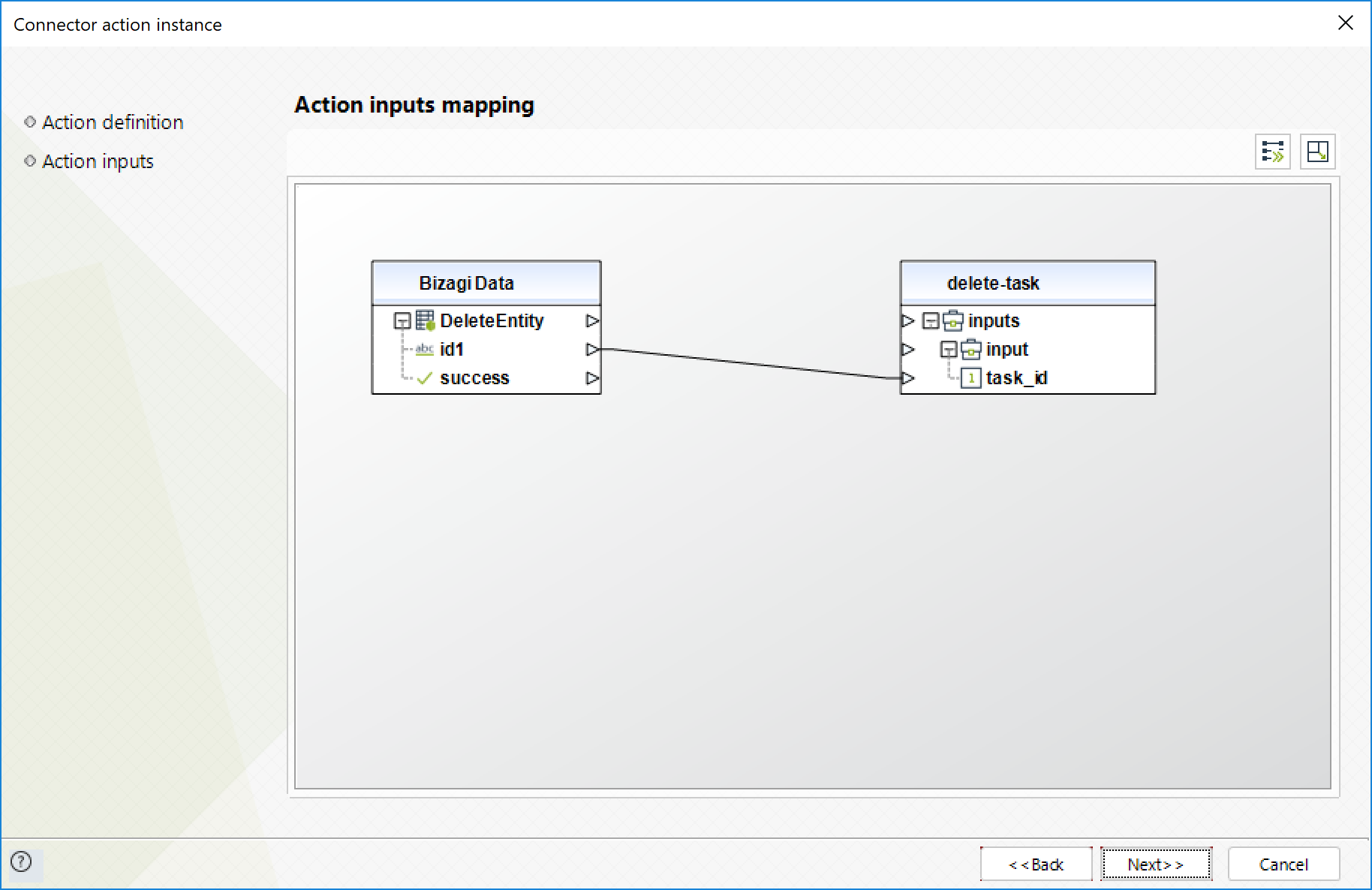
To configure its outputs, you can map the success output to your success attribute:

For more information about this method's use, refer to Asana's official documentation at https://asana.com/developers/api-reference/tasks?missingtranslation=es#delete.
Create Subtask
This action lets you create a new subtask, assign it to an user and add it to one or more projects.

Configure its inputs as follow:
•task_id: The id of the task (required). This parameter should be an integer in your Bizagi model.
•name: the name of the subtask (required). This parameter should be a string in your Bizagi model.
•notes: The notes of the subtask. This parameter should be a string in your Bizagi model.
•due_on: The date when the subtask should be finished. It should be in format YYYY-MM-DD. Ex 2018-12-15. This parameter should be a string in your Bizagi model.
•assignee: The user that will be assigned to the subtask. It can be the id of the user, the email or the string 'me' to assign yourself. This parameter should be a string in your Bizagi model.

To configure its outputs, you can map the response output to your subtask entity in Bizagi and make sure you map the attributes of the subtask appropriately:
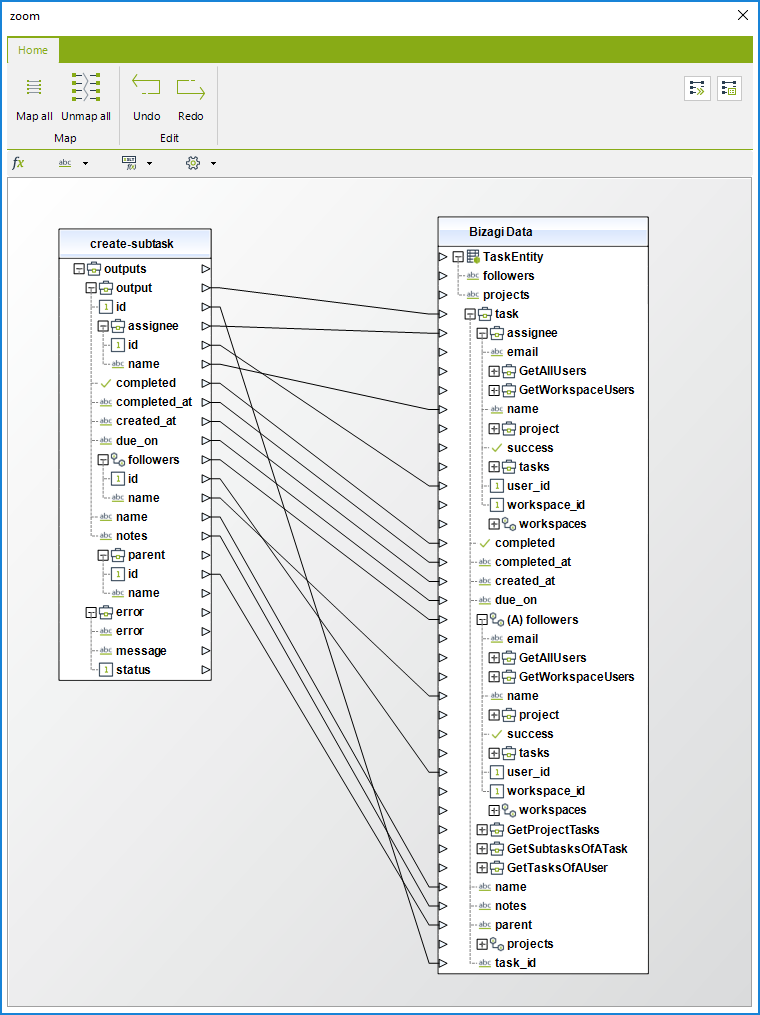
For more information about this method's use, refer to Asana's official documentation at https://asana.com/developers/api-reference/tasks?missingtranslation=es#subtasks.
Get Subtasks Of A Task
This action gets all the subtasks of a task.

Configure its inputs as follow:
•task_id: The id of the task (required). This parameter should be an integer in your Bizagi model.
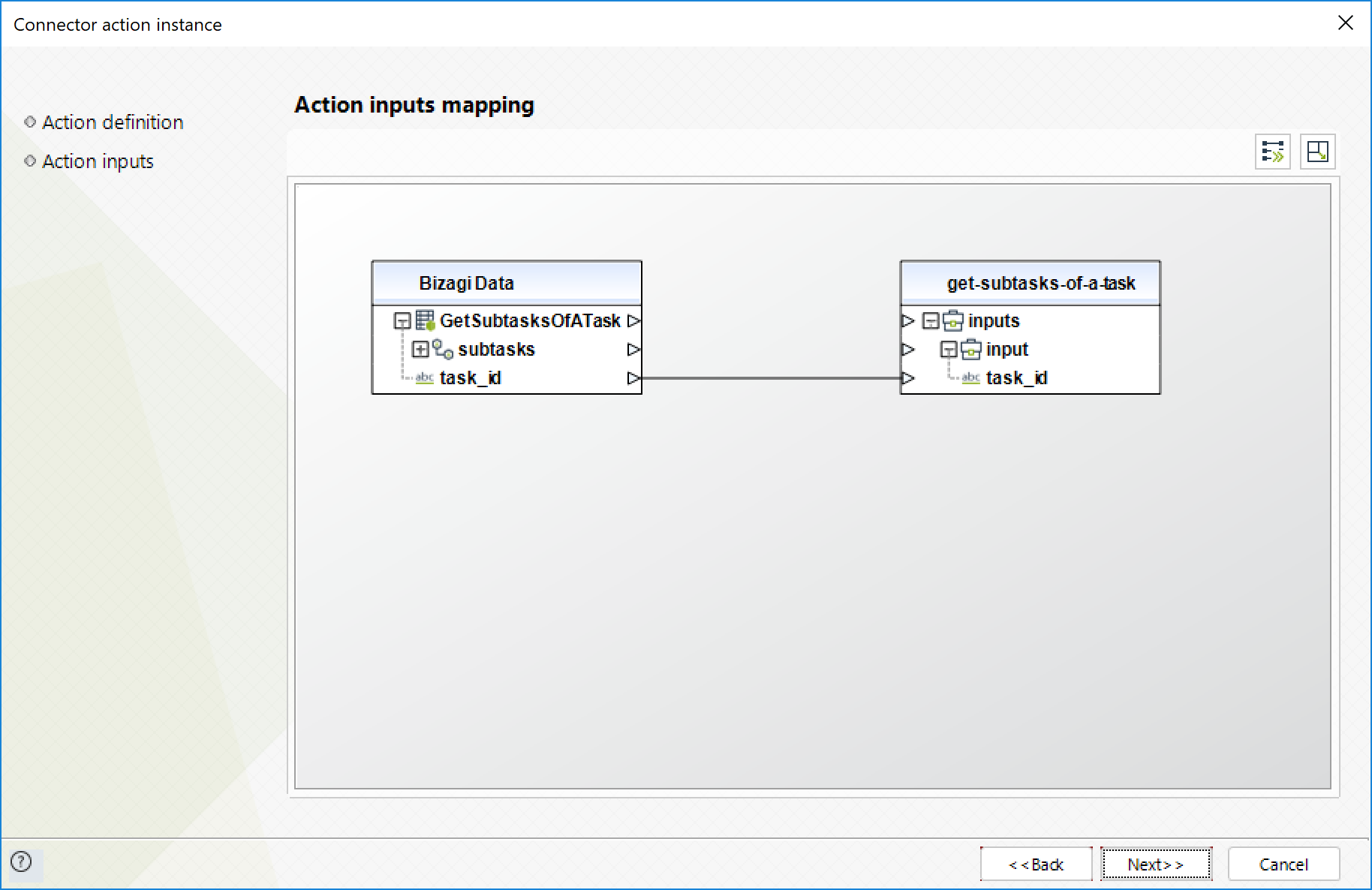
To configure its outputs, you can map the output collection to your subtask collection in Bizagi and make sure you map the attributes of the subtasks appropriately:

For more information about this method's use, refer to Asana's official documentation at https://asana.com/developers/api-reference/tasks?missingtranslation=es#subtasks.
Get Tasks Of A User
This action gets all the tasks of a user.

Configure its inputs as follow:
•workspace_id: The id of the workspace (required). This parameter should be an integer in your Bizagi model.
•assignee: The user that will be assigned to the subtask. It can be the id of the user, the email or the string 'me' to assign yourself. This parameter should be a string in your Bizagi model.

To configure its outputs, you can map the output collection to your task collection in Bizagi and make sure you map the attributes of the tasks appropriately:

For more information about this method's use, refer to Asana's official documentation at https://asana.com/developers/api-reference/tasks?missingtranslation=es#query.
Add Project To A Task
This action lets you add a project to a tasks.

Configure its inputs as follow:
•project_id: The id of the project (required). This parameter should be an integer in your Bizagi model.
•task_id: The id of the task (required). This parameter should be an integer in your Bizagi model.

To configure its outputs, you can map the output entity to your task entity in Bizagi and make sure you map the attributes of the task appropriately:

For more information about this method's use, refer to Asana's official documentation at https://asana.com/developers/api-reference/tasks?missingtranslation=es#projects.
Remove Project From Task
This action lets you remove a project to a tasks.

Configure its inputs as follow:
•project_id: The id of the project (required). This parameter should be an integer in your Bizagi model.
•task_id: The id of the task (required). This parameter should be an integer in your Bizagi model.

To configure its outputs, you can map the output entity to your task entity in Bizagi and make sure you map the attributes of the task appropriately:

For more information about this method's use, refer to Asana's official documentation at https://asana.com/developers/api-reference/tasks?missingtranslation=es#projects.
Add Followers To Task
This action lets you add followers to a tasks.

Configure its inputs as follow:
•followers: The ids of the users separated by comma (required). This parameter should be an integer in your Bizagi model.
•task_id: The id of the task (required). This parameter should be an integer in your Bizagi model.

To configure its outputs, you can map the output entity to your task entity in Bizagi and make sure you map the attributes of the task appropriately:
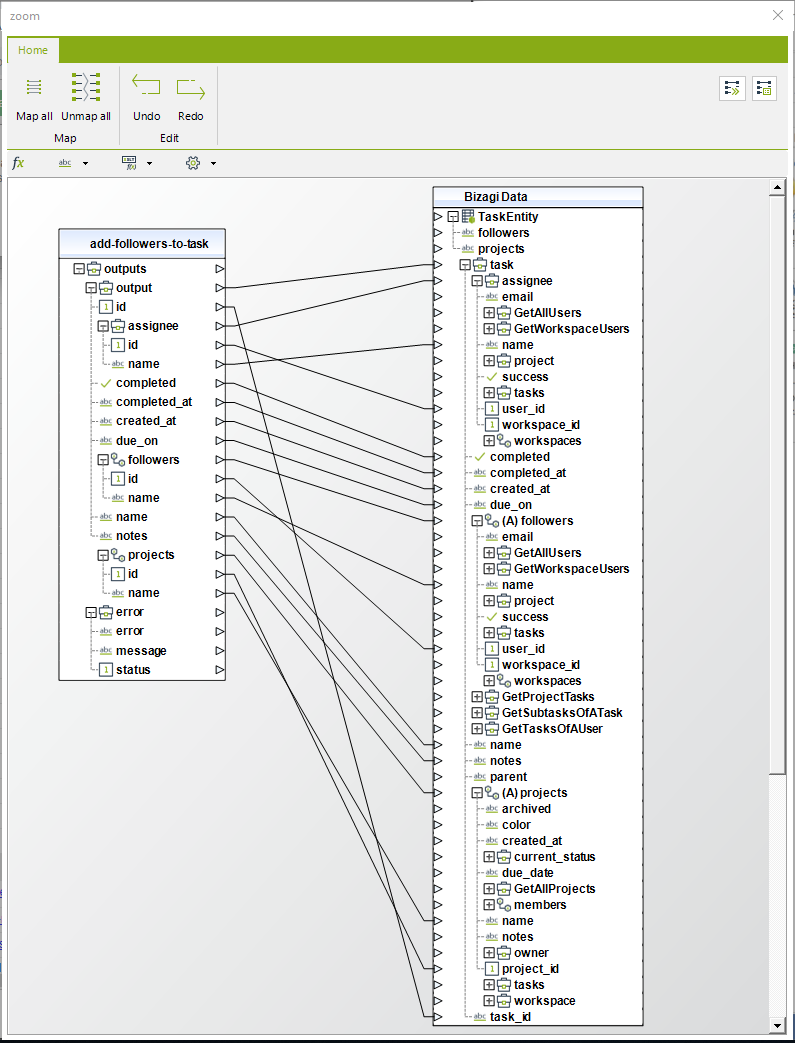
For more information about this method's use, refer to Asana's official documentation at https://asana.com/developers/api-reference/tasks?missingtranslation=es#projects.
Remove Followers From Task
This action lets you remove followers to a tasks.
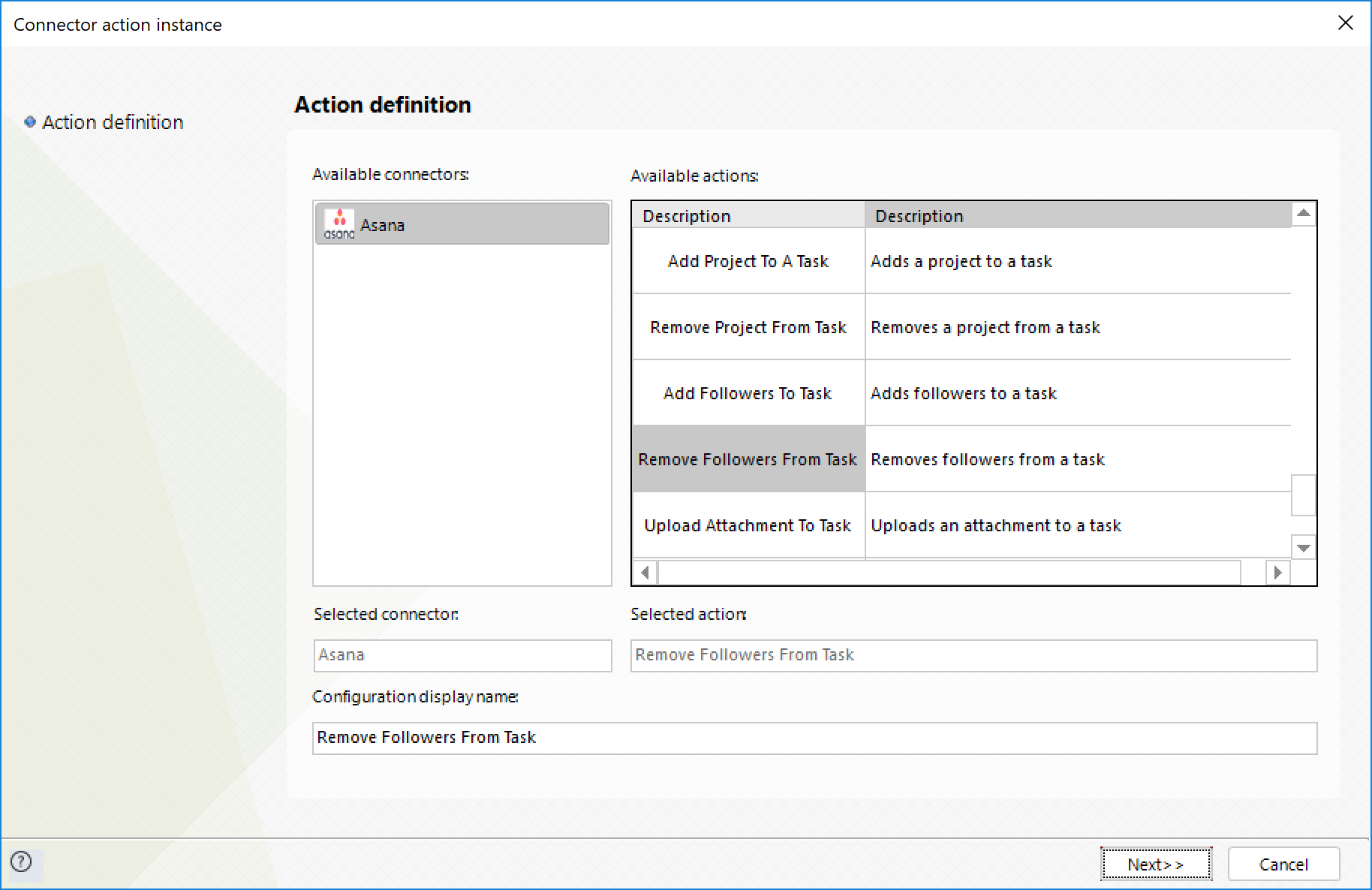
Configure its inputs as follow:
•followers: The ids of the users separated by comma (required). This parameter should be an integer in your Bizagi model.
•task_id: The id of the task (required). This parameter should be an integer in your Bizagi model.

To configure its outputs, you can map the output entity to your task entity in Bizagi and make sure you map the attributes of the task appropriately:

For more information about this method's use, refer to Asana's official documentation at https://asana.com/developers/api-reference/tasks?missingtranslation=es#projects.
Upload Attachment To Task
This action lets you upload attachement to a tasks.

Configure its inputs as follow:
•task_id: The id of the task (required). This parameter should be an integer in your Bizagi model.
•filename: filename of the attachment (required).
•file: base64 data of the attachment (required).
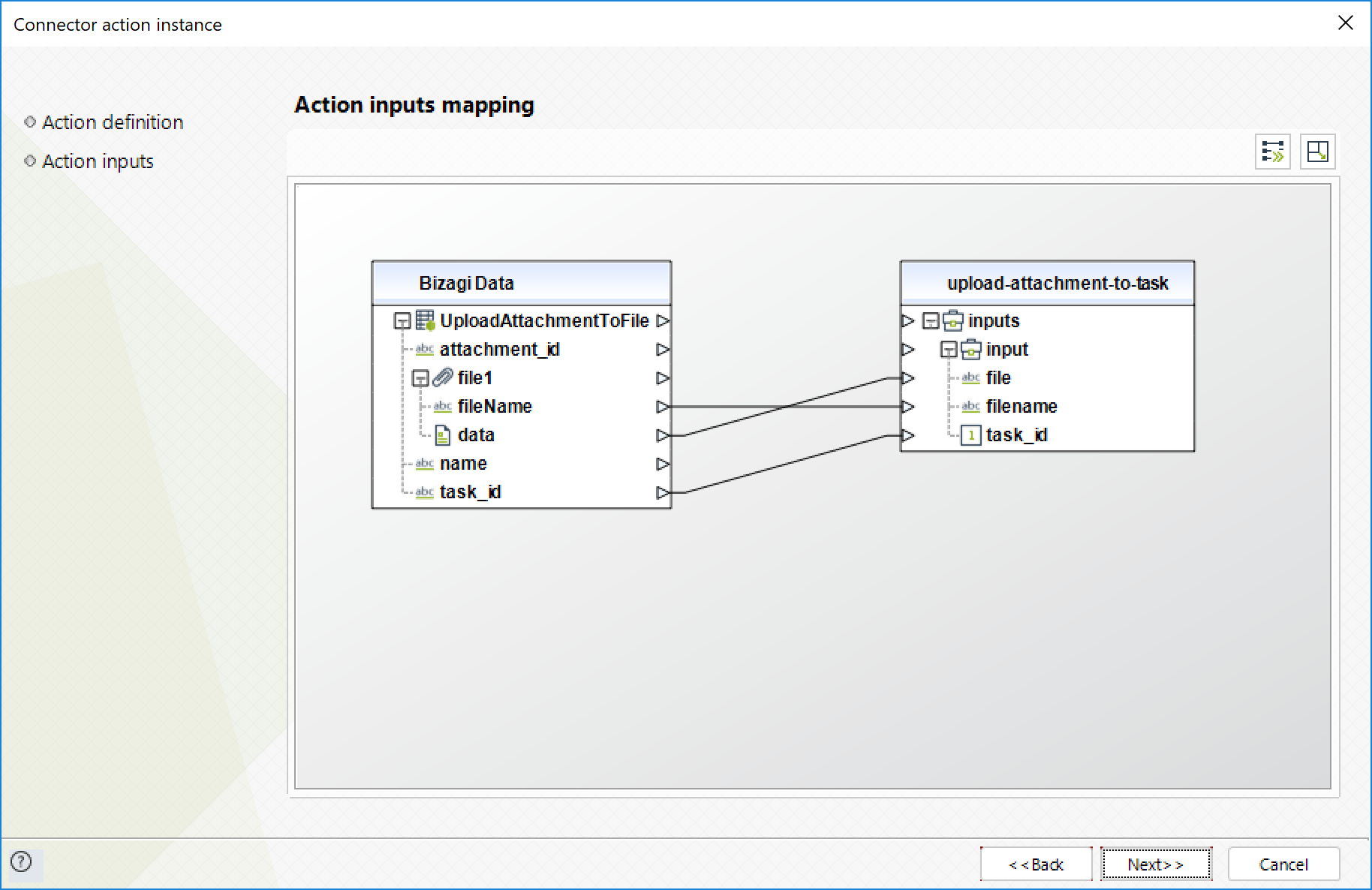
To configure its outputs, you can map the output entity to your task entity in Bizagi and make sure you map the attributes of the task appropriately:
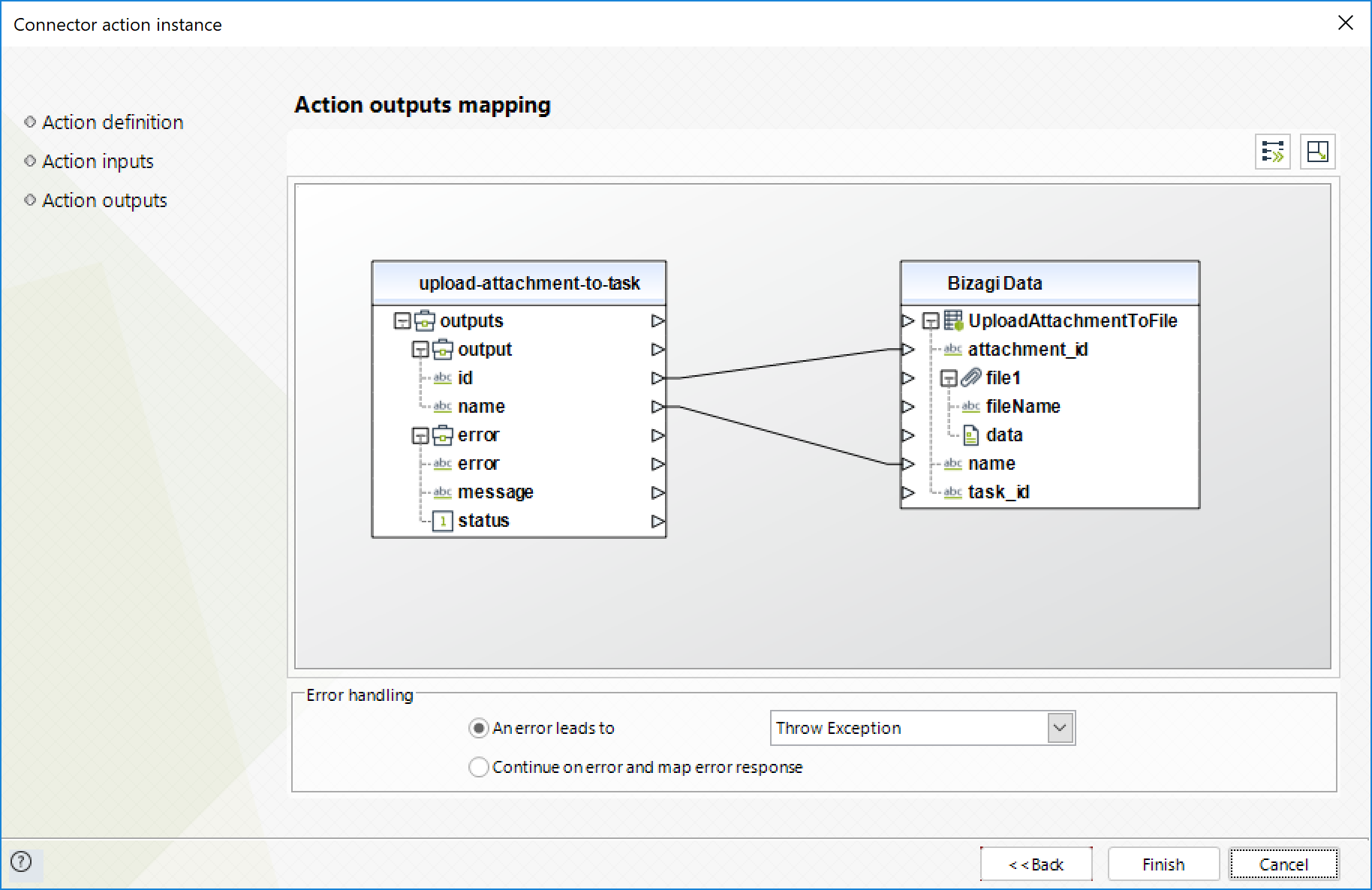
For more information about this method's use, refer to Asana's official documentation at https://asana.com/developers/api-reference/attachments?missingtranslation=es#upload
Get Attachment
This action gets a specific attachment

Configure its inputs as follow:
•attachment_id: The id of the attachment (required). This parameter should be an integer in your Bizagi model.

To configure its outputs, you can map the output entity to your attachment entity in Bizagi and make sure you map the attributes of the attachment appropriately:
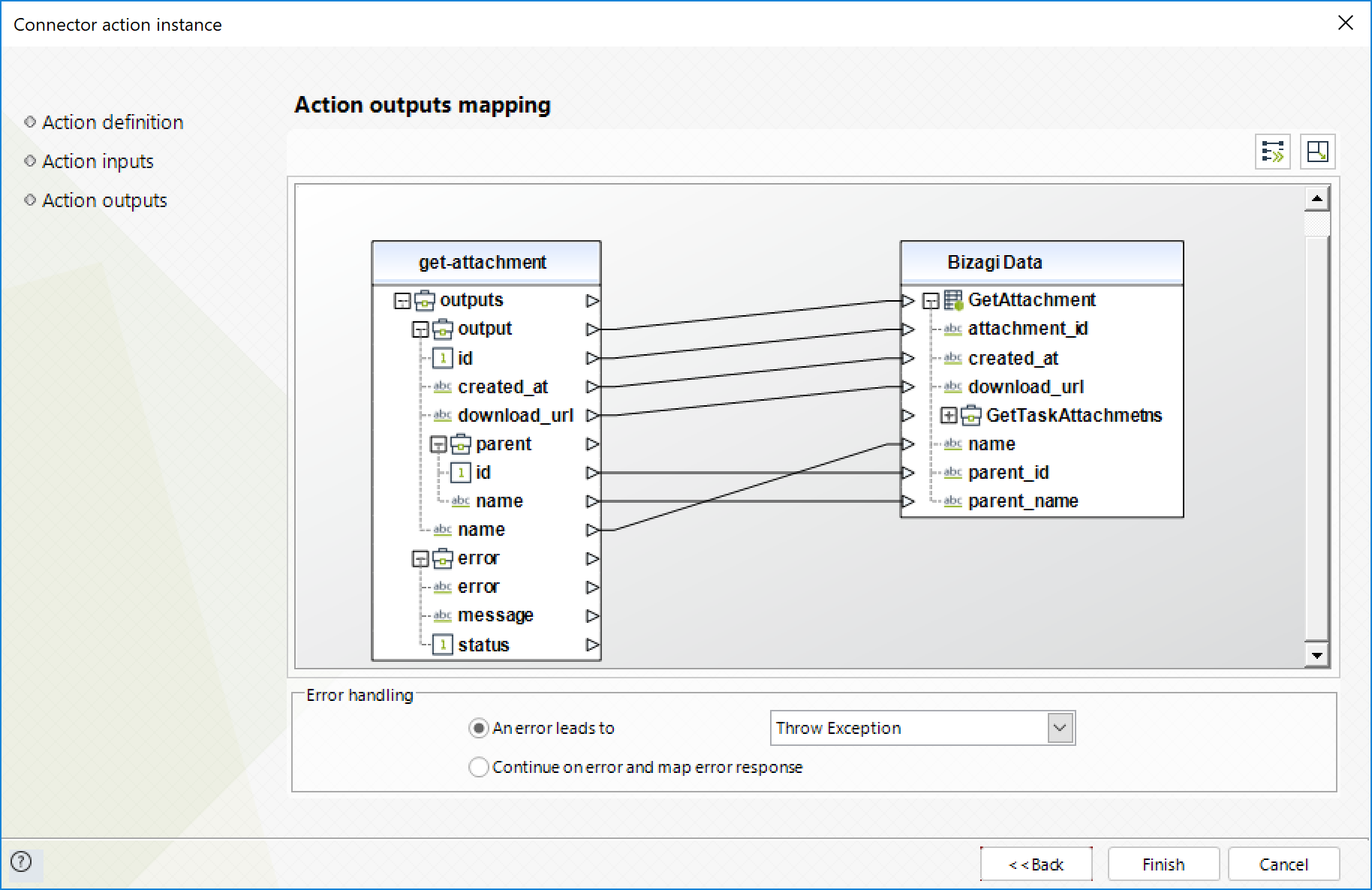
For more information about this method's use, refer to Asana's official documentation at https://asana.com/developers/api-reference/attachments?missingtranslation=es#get-single.
Get Attachments Of A Task
This action gets all the attachments of a task.

Configure its inputs as follow:
•task_id: The id of the task (required). This parameter should be an integer in your Bizagi model.

To configure its outputs, you can map the output collection to your attachment collection in Bizagi and make sure you map the attributes of the attachment appropriately:

For more information about this method's use, refer to Asana's official documentation at https://asana.com/developers/api-reference/attachments?missingtranslation=es#get-all-task.
Last Updated 10/27/2022 9:54:22 AM